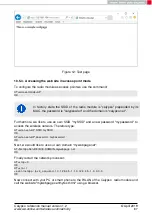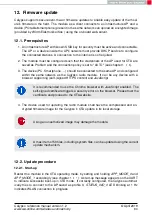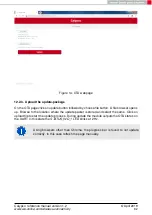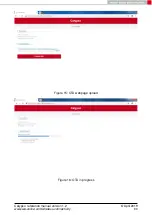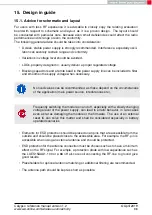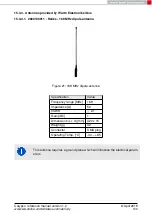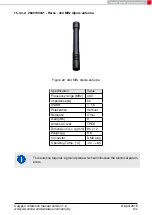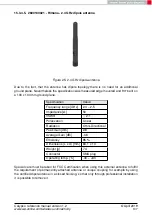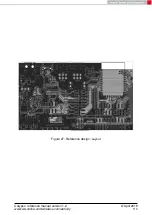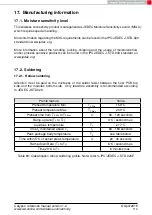
will lead to a trace width of W
∼
1.9 mm. To ease the calculation of the micro strip line (or
e.g. a coplanar) many calculators can be found in the internet.
• As rule of thumb a distance of about 3×W should be observed between the micro strip
and other traces / ground.
• The micro strip refers to ground, therefore there has to be the ground plane underneath
the trace.
• Keep the feeding line as short as possible.
15.3. Antenna solutions
There exist several kinds of antennas, which are optimized for different needs. Chip anten-
nas are optimized for minimal size requirements but at the expense of range, PCB antennas
are optimized for minimal costs, and are generally a compromise between size and range.
Both usually fit inside a housing.
Range optimization in general is at the expense of space. Antennas that are bigger in size,
so that they would probably not fit in a small housing, are usually equipped with a RF con-
nector. A benefit of this connector may be to use it to lead the RF signal through a metal
plate (e.g. metal housing, cabinet).
As a rule of thumb a minimum distance of
λ
/10 (which is 3.5 cm @ 868 MHz and 1.2 cm @
2.44 GHz) from the antenna to any other metal should be kept. Metal placed further away
will not directly influence the behavior of the antenna, but will anyway produce shadowing.
Keep the antenna away from large metal objects as far as possible to avoid
electromagnetic field blocking.
The choice of antenna might have influence on the safety requirements.
In the following chapters, some special types of antenna are described.
15.3.1. Wire antenna
An effective antenna is a
λ
/4 radiator with a suiting ground plane. The simplest realization is
a piece of wire. It’s length is depending on the used radio frequency, so for example 8.6 cm
868.0 MHz and 3.1 cm for 2.440 GHz as frequency. This radiator needs a ground plane at
its feeding point. Ideally, it is placed vertically in the middle of the ground plane. As this
is often not possible because of space requirements, a suitable compromise is to bend the
wire away from the PCB respective to the ground plane. The
λ
/4 radiator has approximately
40
Ω
input impedance, therefore matching is not required.
Calypso reference manual version 1.2
© April 2019
www.we-online.com/wireless-connectivity
101

